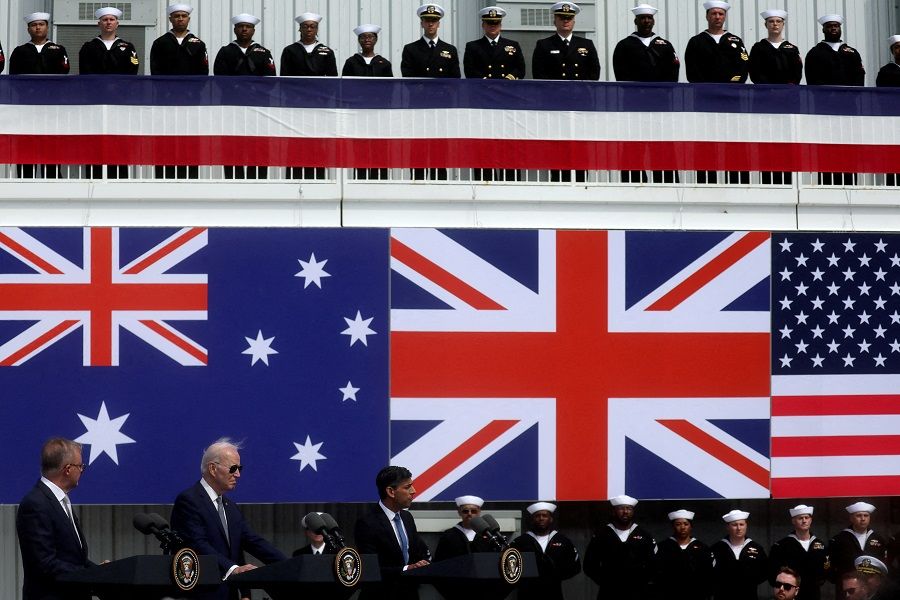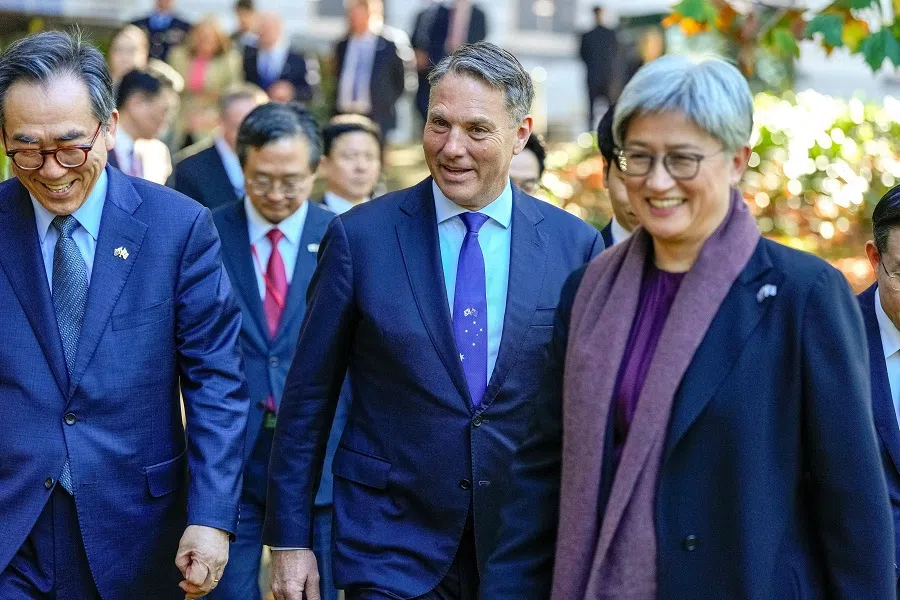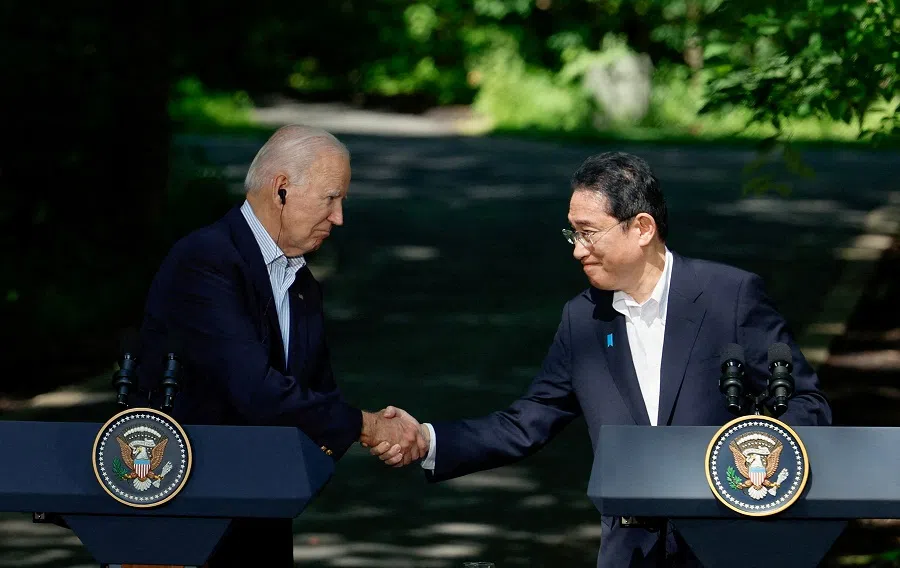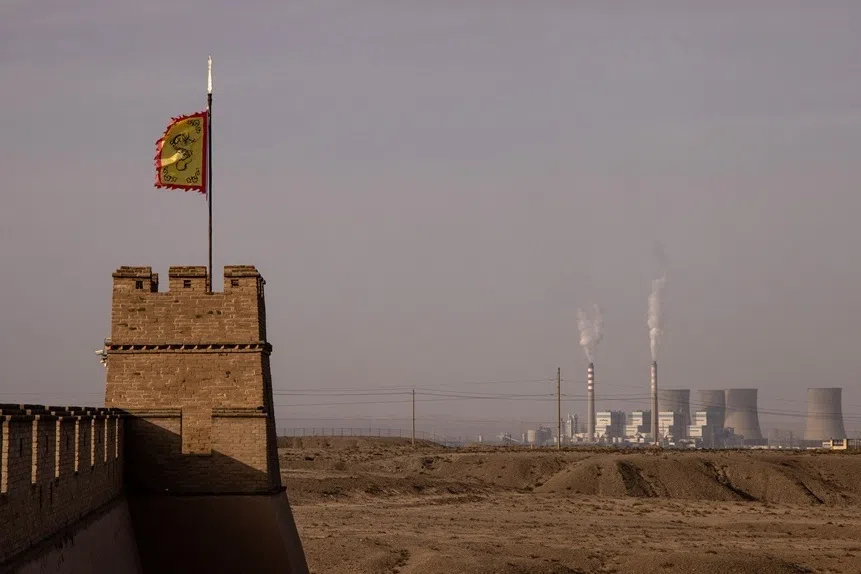Why AUKUS’s expansion is inevitable
Chinese military affairs commentator Song Zhongping thinks that AUKUS is turning into a new military organisation that promotes the exchange of advanced new military technologies and technological expansion. He explains why China is highly concerned about countries in the region and even NATO looking to be involved with AUKUS.

In April 2024, US President Joe Biden met with Japanese Prime Minister Fumio Kishida in Washington. They discussed the possibility of Japan being part of “AUKUS Pillar II”. Soon after, during the South Korea-Australia “2+2” Foreign and Defence Ministers’ Meeting, there was talk of South Korea being part of AUKUS Pillar II too. Once news broke of Japan and South Korea wading into the muddy waters of AUKUS, the international community was in an uproar. What is AUKUS, and why are Indo-Pacific countries so eager to join it?
On 15 September 2021, with a joint statement affirming the three countries’ resolve to deepen defence cooperation, US President Biden, then UK Prime Minister Boris Johnson and then Australia Prime Minister Scott Morrison announced the creation of AUKUS. As Australia wanted to leverage the expertise of the US and the UK for nuclear-powered submarines, the AUKUS military alliance was formed.
AUKUS is a new global military organisation with the US, UK and Australia at its core. But it is the US that gave it its new, true mission.
A military organisation that surpasses NATO
Firstly, AUKUS is a new military organisation that occupies a much higher position than NATO.
While NATO has 32 member countries, it is a loosely organised group of mainly European countries, with a focus on the safety of Europe and the Atlantic. The distribution of labour and status of each member is clear, and the US is the backbone of NATO as well as its only leader. France and other countries’ efforts to gain control of the organisation are in vain.
Most NATO members are just following the US’s NATO policy; NATO does not have independent and autonomous military decision-making powers. The so-called NATO collective defence is more a collective defence with the US at the heart of it; only when the US agrees to this collective defence would it materialise.
... it [AUKUS] is about becoming a key military organisation with military technology transfer at its core.

Most NATO members purchase arms and equipment from the US and other key NATO countries; they simply uphold their NATO obligations without enjoying the rights that they deserve from being part of NATO.
AUKUS is a different kind of organisation. It is not just about building up collective defence mechanisms. Rather, it is about becoming a key military organisation with military technology transfer at its core. Take the example of Australia leveraging the US and UK for their submarine technology; that in itself is a key breakthrough for sensitive technology.
Why call it a “key breakthrough”? This is because Russia once faced opposition from the international community just for leasing a nuclear submarine to India, without any transfer of technology, much less to say exporting an entire nuclear submarine to India. But there is technological transfer within AUKUS, and even the sale of an entire submarine; is this not then, a key breakthrough?
In fact, achieving the breakthrough of nuclear technology transfer is but the first step for AUKUS — at the same time, they would enhance cooperation in areas such as artificial intelligence (AI), biotechnology, new materials, hypersonic weapons, among other fields. In essence, it is about turning AUKUS into a new military organisation that facilitates an exchange of advanced new military technologies as well as technological expansion; this is something that is unimaginable for NATO internally.
The essence of NATO is more like a mutual defence assistance alliance, and would not entail technological transfer — especially for the exchange of core sensitive technologies. Evidently, AUKUS is a new military organisation that occupies a position much higher than NATO.
Instrument to further the US’s interests in the Indo-Pacific
Secondly, NATO’s eastward expansion is a false proposition that is entirely unrealistic. NATO has 32 member nations, each with their own agenda, with the US more concerned about leveraging NATO to maintain its hegemony in Europe; the US would not undertake the responsibility of NATO’s collective defence.
The US wishes to see NATO expand eastward but as NATO members are mostly European countries, they are more seized with the safety of their own countries and regional security; there is a limit to their concern for the Indo-Pacific region. Only a few NATO countries — spurred on by the US — are concerned about developments in the Indo-Pacific region. Thus, the US sees huge obstacles hindering NATO’s eastward expansion into the Indo-Pacific region.
NATO’s eastward expansion is unrealistic and a false proposition — to counter China, the mantle falls upon AUKUS, and not NATO.

It is undeniable that NATO’s main target is Russia, and if Russia is kept in check, the US’s strategic interests and hegemony in Europe would be kept intact. Thus, the US is not counting on NATO to realise true globalisation. In fact, the US is keenly aware that it is unrealistic to rely on NATO members to collectively counter China; they view Russia as the threat, not China located in the Indo-Pacific region. Clearly, NATO’s eastward expansion is unrealistic and a false proposition — to counter China, the mantle falls upon AUKUS, and not NATO.
Global, not regional hegemony
Thirdly, AUKUS is key in the US’s new global hegemony. In its first phase, AUKUS brought three major countries — US, UK and Australia — together. These countries could be called key set pieces in the US’s global strategy. Though the UK is in Europe, Australia is in Oceania and the US is in North America, the three are more heavily involved in the Indo-Pacific region; hence it can be argued that AUKUS is an important pillar in the US’s new global hegemony.
NATO can only help it realise the regional hegemony in Europe; in terms of global hegemony, the US still lacks support in the Indo-Pacific region. Be it the US-Japan military alliance, the US-South Korea military alliance, or the US-Japan-South Korea military alliance which looks to be shaping up, the US-Australia military alliance or other new US military alliances, the US alliances in the Indo-Pacific region are currently mostly bilateral or trilateral military alliances — it would be difficult to form a military organisation in the vein of a seemingly powerful NATO.
Thus, the US’s forming of AUKUS is certainly done in its own interest, as only by doing so can they have the key support they need in their pursuit of new global hegemony.
The US can achieve hegemony in Europe via NATO, and do the same in the Indo-Pacific region through AUKUS, thus maintaining global hegemony.
At the same time, integrating the various bilateral military alliances in the Indo-Pacific region and making them key components for AUKUS members is also an important consideration for preserving US hegemony. The US can achieve hegemony in Europe via NATO, and do the same in the Indo-Pacific region through AUKUS, thus maintaining global hegemony.
Strategic planning with China in mind
Fourthly, it goes without saying that AUKUS’s goal is to target China. The fact that the US got Australia to set up a nuclear submarine force although the latter had no intrinsic need for one shows that this was never to serve Australia’s national security interests. Rather, the US wants Australia to get more involved in Indo-Pacific affairs and even South China Sea matters. The UK, which made its way from Europe to the Indo-Pacific region, likewise seeks to be involved in Asia-Pacific and target China.

Looking at the set-up of AUKUS, the grouping is geared towards fulfilling the US’s Indo-Pacific strategy. Since the launch of that strategy, the US has been gathering more countries via AUKUS to contain a growing and rising China. Finding it hard to go one-on-one with China, it aims to inhibit China’s growth via a military alliance. Seen in that light, it is no wonder that the US entrusted AUKUS with the huge responsibility of expanding and enhancing its capacity to address the challenge posed by China.
At the same time, the US prefers adopting hybrid warfare against countries such as China and Russia. Hybrid warfare relies on the combined combat power of the US and its allies — not the US alone — to fight against major powers such as China and Russia. For example, in the decoupling and supply chain disruptions of the trade, economic and technology sectors, relying on the US alone to impose a strategic blockade on China is not enough. The West and the countries against China and Russia must come together to strike where it hurts in markets, the economy, trade and technology.
Another important goal of AUKUS is to help US arms manufacturers promote their military equipment; not only to transfer US ready-made weapons and equipment, but also to promote US military technology to other countries. By doing so, the US has in fact violated the Treaty on the Non-Proliferation of Nuclear Weapons without batting an eyelid, including the transfer and dissemination of nuclear technology. Although this is a clear violation of international law, the US believes that the move will help contain China’s growth, which is one of the US’s considerations.
This makes Japan an important bridgehead in the US’s containment of China, which aligns with US interests.
Possible addition of NATO members and US allies in Indo-Pacific
Fifth, the progressive expansion of AUKUS will become inevitable.
The first members of AUKUS were the US, the UK and Australia. Japan has made positive signals towards AUKUS Pillar II, while Canada has expressed interest as well. Why did the US first prioritise the membership of these countries? For one, the US hopes to establish hegemony in Europe with the help of the UK, which is the spokesperson for the US’s hegemonic interests in Europe.

It is an established fact that a post-Brexit Britain helps maintain US leadership in Europe. Notably, the UK has an inherent say in NATO and is also an important agent of the US. The US’s authority in NATO can be safeguarded with the UK suppressing Germany and France. This is the reason why the US chose the UK as one of the main members of AUKUS.
Why did the US also choose Japan to be involved with AUKUS? Apart from Japan’s relatively powerful economy and military capability, the country is also involved in a territorial dispute with China, and shares historical problems with it. This makes Japan an important bridgehead in the US’s containment of China, which aligns with US interests.
The next step in the expansion of AUKUS will be the inclusion of certain NATO members, as well as US allies in the Indo-Pacific region.
Both Australia and Canada are sparsely populated countries with massive strategic spaces and buffers. They are also rich in resources and energy, which is very useful as a strategic depth for the US’s fight against China. Through this series of operations, the US could even direct war into these countries, including its own allies, so as to escape unscathed.
The next step in the expansion of AUKUS will be the inclusion of certain NATO members, as well as US allies in the Indo-Pacific region. This could possibly include South Korea, Singapore, New Zealand, Thailand and so on. New AUKUS members among NATO members could include Germany, the Netherlands and Spain, further reinforcing the inevitability of the expansion of AUKUS.
Not only is AUKUS expansion inevitable, but so is the grouping’s continued targeting of China. Resisting AUKUS is now one of China’s key preoccupations. Firstly, it has to divide and demolish AUKUS in the diplomatic arena so that its goals would not be achieved. Secondly, it has to up its capabilities and potential to tackle the massive challenges that AUKUS poses.
With China’s active efforts, if AUKUS fails to contain China or further expand, the bloc will become an important sign of the total collapse of US hegemony.





